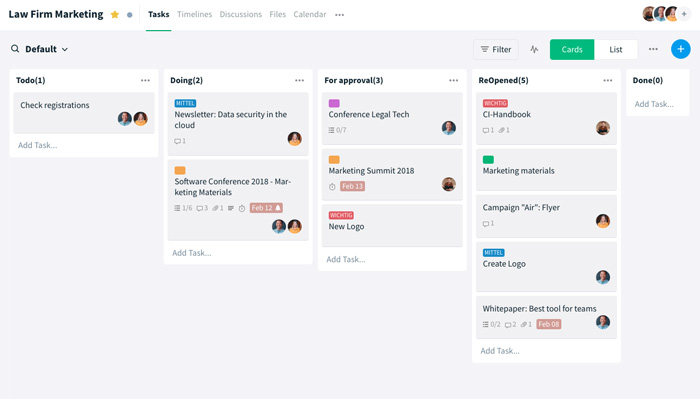Law firms and IT companies - they are as different as companies can be. Comparing them is like comparing apples and oranges. Most people would agree with this statement without a second thought. But as different as these two businesses are, there are some things that a law firm could learn from the IT industry. This opinion is also shared by Joanna Kingston Davies, COO of the Jackson Lees Group - a law firm from Liverpool.
If you now want to know how law firms can benefit from the very different IT processes, read on:
Why comparing legal management and IT project management?
While law is a discipline as old as the ancient civilizations, IT business is just a couple of decades old, which makes it a relatively new field. Of course, this doesn’t make one of the fields better than the other – but it does make them very distinct from each other. Acknowledging the different approaches to certain processes in turn offers the potential for improval - and legal management can definitely benefit from having a look at how IT firms handle their project management.
Law companies tend to stick to the well-trodden paths and methods that have been in use for years. The IT field, on the other hand, is changing rapidly. Many of the practices that have been considered standard a couple of years before are now considered outdated. In general, IT business is for many the epitome of agility, efficiency and innovation.
We asked Joanna Kingston-Davies, Chief Operating Officer at The Jackson Lees Group, a law firm from Liverpool, to share her thoughts on the subject:
"The legal services sector in general tends to be very rules-based and traditional in both structure and operating model. Some of the best IT companies we have come across seem to set themselves up to facilitate and promote innovation far more effectively than I think we do in our industry."
Agile legal management: What a law firm can learn from an IT company

When it comes to law firms, their workflow is usually dictated by the procedures and the law itself. This may sound like there isn’t much space for improvement in legal management. Obviously, the legal constraints here are particularly strict (which is hardly a surprise), but it’s always refreshing to look at the workflow and processes from a different perspective.
Young disciplines, like IT, can be a source of valuable inspiration for making day-to-day work more productive and even more enjoyable for the employees.
Software companies today make their processes much more adaptable than was usual in traditional project management. This is what is referred to as agility. But what does Agile actually mean?
The idea behind agile approaches is to be less constrained by rigid process instructions and thus to be able to react to changes in requirements at any time. So IT experts adapt their processes to the projects, they constantly try new approaches to make communication with their customers and business partners even easier and smoother and ultimately make their work even more efficient. But how exactly do you do that?
Agile Manifesto
Teams whose day-to-day bread and butter is the handling of IT projects now work according to a few principles that a group of IT pioneers wrote down a few years ago in the much-cited Agile Manifesto. Not all of these principles are unconditionally suitable for every industry. Nevertheless, you can spot some valuable points for legal management.
Flexibility
"Welcome changing requirements, even late in development. Agile processes harness change for the customer's competitive advantage".
Modern IT companies place an incredibly high value on flexibility. Why? Because flexibility is ultimately the one trait that enables top companies to drive innovation and bring about change. Rigidity, on the other hand, leads to stagnation.
Agile teams do not follow a strict process plan that is scheduled from start to finish. Instead, they try to make their process decisions once all the necessary information is available.
If you think about it more carefully, you will understand why. Only those who are able to react to changing market conditions and changing product requirements will ultimately succeed in delivering the best possible result with the greatest possible efficiency.
Some people may think, "Fair enough, but a lawyer doesn't design a new kind of product that has to compete with a multitude of competing products on the market." This may be true. However, flexibility goes much further than that. This becomes clear as soon as one realizes that although the core business of a law firm does not change fundamentally, the environment in which the firm operates does: the employees, the clients, the way they work together...
At this point you realize that there are many areas in which law firms can benefit from agility and especially from flexibility. The labour market demands more flexible jobs (working hours, home office, etc.). New talents are entering professional life as digital natives and expect modern technology in the workplace. Even clients who no longer have a traditional nine-to-five job themselves have different communication requirements - in particular, more transparency in terms of performance and consideration. In this context, lawyers have no choice but to become flexible and adapt their legal management to the changing circumstances.
Simplicity
"Simplicity - the art of maximizing the amount of work not done - is essential".
This phrase from the Agile Manifesto may be a misconception for some people. After all, a lawyer wants his work to be done, not piled up. Are software developers not interested in progressing? Yes, and that is exactly the point.
In fact, this statement is not about piling up work, but about doing exactly the opposite: Maximize work not done - that is, to avoid doing work that is not absolutely necessary.
Lawyers tend to do everything as seamlessly as possible so they cover everything that could possibly be relevant.
Of course, this approach is essential for legal management when it comes to securing an advantage over the other party. In day-to-day business, however, such meticulousness can be a hindrance.
Agile teams therefore want to keep their processes as simple as possible. They divide their work into individual work steps (usually recorded in a product backlog) and then prioritise them. What is essential? What must be done first? What can you skip? Once the next intermediate result has been achieved, it will become clear which steps are necessary in the next sprint.
By the way, one of the highest principles in software development is to formulate work instructions as simply as possible to avoid misunderstandings. User stories that describe a function are therefore written down in simple language as straightforward as possible. However, expressing oneself in simple terms is usually not part of the toolkit of a lawyer. The ordinary citizen who wants to consult a lawyer is usually not a great friend of "legal terminology", but sees a great advantage in the fact that things are presented in a comprehensible and transparent way.
Motivation & trust
"Build projects around motivated individuals. Give them the environment and support they need, and trust them to get the job done."
Although this seems like a basic rule, we all know it’s usually easier said than done. IT companies put a great emphasis on mutual trust.
When the employees feel respected and get a certain degree of freedom, they’re more likely to deliver better results. This may not always be the case in law firms, where older, more experienced professionals are not so keen on trusting new joiners to get the job done well enough. If there is one thing they can learn from IT companies, it’s letting go and trying to see if the employee will actually perform better if they get more freedom and a sense of ownership. Of course, it’s not about changing the mindset completely – it’s more about trying out new approaches. Some will notice that even experienced senior partners - and therefore also legal management - can benefit from the different way of thinking of younger colleagues. If the employees feel that trust, they also trust in themselves and are more motivated to drive projects forward with their own ideas.
Teamwork & communication
"Business people and developers must work together daily throughout the project."
In IT, a project depends on a functioning cooperation within a self-organized, cross-functional team: everyone makes his or her contribution, everyone is an expert in his or her field of work, everyone bears responsibility. Steep hierarchies are considered to be a hindrance, because they make it impossible for the individual to fully develop and contribute in the best possible way. On the other hand, law firms are still regarded as representatives of hierarchical work structures and delegation. According to Kingston-Davies, however, it would also make sense in the legal sector to flatten them out a little:
"We are really passionate about promoting the value of a diverse team with different approaches – this helps us to deliver the best solutions to our clients and to each other, and to look at things from all angles."
A team with many different personalities from different disciplines, as Kingston-Davies describes, makes it possible to look at cases from different angles, think about things in different ways and ultimately find the best solution for the client.
According to Kingston-Davies, specialists in project management could provide considerable value by enriching the legal management with project management approaches that help to promote more efficiency in the projects of the law firms:
"In the future we would love to have more people within the business who are specialised in project management to add value in structuring and helping to drive our projects forward."
What cooperation within such a "diverse team" inevitably requires is smooth communication. Especially in IT, one might think, communication is exclusively digital. This is not the case at all. One of the 5 core disciplines in Scrum, which is probably the most widely used project management method in IT companies, is the so-called Daily Scrum - a daily meeting in which all team members coordinate their work and update each other face-to-face. Although digital collaboration tools are essential for daily team communication, plans and information about important issues are still best communicated in a direct conversation.
"The most efficient and effective method of conveying information to and within a development team is face-to-face conversation."
Legal Tech: Use the right collaboration tool for legal management

Even though the classic face-to-face meeting is still highly valued, IT companies use various communication and project management tools to make collaboration more efficient. As their everyday work is all about software, they’re well aware how dedicated tools can help them with productivity.
A very common tool for task management, which is part of various collaboration tools, is the Kanban Board. The board visualizes task workflows within different status columns. In IT it usually consists of status columns like "To Do", "In process", "Review" and "Done", but the board can be individually adapted to own workflows. In this way, everyone knows about the current processing status and project progress with just a quick glance. This system is helpful in managing the amount of work in the pipeline and keeping track of the team’s progress. It is also worth noting that the Kanban method is about focusing on one particular task instead of multitasking.

What about the law firms? We asked Kingston-Davies about the use of digital solutions:
"We use personality profiling tools that work really well for us, although I’m sure we could get better by implementing more bespoke technology to facilitate collaborative working more effectively, rather than trying to fit teamwork into outdated systems or processes."
As we can see from our numerous clients in this sector, project management software also has a place in the legal world and is well accepted. It is important to choose a solution that meets the high security requirements that legal professionals must meet.
What about §203?
Lawyers and tax consultants process highly sensitive data and, like all professionals sweared to secrecy, they must guarantee full protection for all data. Here’s where Stackfield comes in handy.
Stackfield is aimed in particular at those professional groups that place high demands on data protection and meets them with security standards that even exceed the strict GDPR regulations. These include, for example, client-side end-to-end encryption, the highest SSL standards and servers located exclusively in Germany. More information about data protection with Stackfield: https://www.stackfield.com/security
Old habits die hard - but for the good
We know: ...it's not easy to break old habits. However, change doesn't always have to be a bad thing and many law firms can certainly benefit from looking at their work from a different perspective as well as from trying out new things. Finally, legal management becomes a little bit more agile.